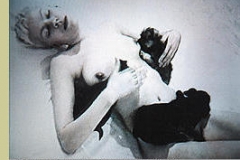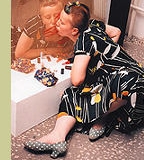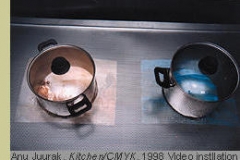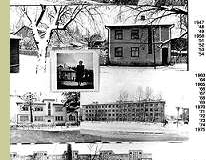In 1995, the EST.FEM exhibition took place. Mare Tralla, also a curator of  the show, exhibited her photo installation This is how we gave birth to Estonian feminism. This was the first work in Estonian art that openly declared itself as feminist art. If the principle of how the author regards herself and her art determines feminist art, then the history of Estonian feminist art began in 1995 with the above-mentioned installation. But if the inherent possibility to interpret art from the point of view of feminism,i.e. a woman’s identity, is considered, then feminism can be realised. The latter version must then be called unconscious feminism. The first exhibition of feminist art was held a year earlier, in 1994. True, in the Swedish-Estonian joint project Kood-eks (Code-Ex),the Swedes involved were much more active in observing the relations between women and society. The Estonian side merely interpreted what was already there, from the feminist point of view. There were exceptions like Anu Põder and her Softly in the Light; its soft body sculptures strived to demonstrate the real strength of the ‘physically weaker’. The combination I-Image by Reet Varblane, the author of this article, incorporated Karin Luts and Epp Maria Kokamägi’s self-portraits. Its aim was to reveal narcissism as one of the main categories of psychoanalysis, and to point out its various levels.
the show, exhibited her photo installation This is how we gave birth to Estonian feminism. This was the first work in Estonian art that openly declared itself as feminist art. If the principle of how the author regards herself and her art determines feminist art, then the history of Estonian feminist art began in 1995 with the above-mentioned installation. But if the inherent possibility to interpret art from the point of view of feminism,i.e. a woman’s identity, is considered, then feminism can be realised. The latter version must then be called unconscious feminism. The first exhibition of feminist art was held a year earlier, in 1994. True, in the Swedish-Estonian joint project Kood-eks (Code-Ex),the Swedes involved were much more active in observing the relations between women and society. The Estonian side merely interpreted what was already there, from the feminist point of view. There were exceptions like Anu Põder and her Softly in the Light; its soft body sculptures strived to demonstrate the real strength of the ‘physically weaker’. The combination I-Image by Reet Varblane, the author of this article, incorporated Karin Luts and Epp Maria Kokamägi’s self-portraits. Its aim was to reveal narcissism as one of the main categories of psychoanalysis, and to point out its various levels.
The Mother-Figure of Estonian Feminist Art
Mare Tralla is undoubtedly a central figure in Estonian feminist art. She is an artist, curator, promoter and a media personality. Her video and photo installation This is how we gave birth to Estonian feminism was, and still is, no less than symptomatic; it denotes the tendencies of Estonian feminist art quite vividly. Mare Tralla shows, through the eyes of a man, woman as a helpful, pretty flower-girl and a submissive and passionate heroine of porn films – the Soviet ideal of the 1970s. In the video, passive women alternate with apparently active, middle-aged or older, socially secure, male leaders. Tralla’s attitude towards what is presented is contemplatively distanced and seems almost equally passive as her women. With Tralla, everything is a little more complicated. The notion of passivity contains several levels. Woman as an object has humbly accepted her role. Woman as a subject not only reflects other women, but herself as well. The artist’s conscious position also contains an ironic attitude towards her subject matter. Besides the opposition between man/woman, the maximally enlarged pornographic situations acquire another dimension – as abstract, pictoral spaces, they start to function as ‘pure’ and ‘high’ art, which in the history of art has been habitually associated with man. The pictorial action is accompanied by the author’s voice as she reads from the diaries of her childhood Young Pioneer days. In this role-reversal, Tralla has become a little girl who rejoices about ‘little pranks’ and is ashamed of the failures. The whole work is carried by a peculiar ambivalence; it is difficult to decipher whether the author controls the subject matter or whether the subject matter manipulates the author. Mare Tralla’s installation reveals the favorite tendency in Estonian feminist art, autobiography, and its most common version, retelling the past through the eyes of a child.
Tralla partly retains this innocent position in the cyber art work her.space (1997-98), in which she plays with the signs of a Soviet woman like a thrilling computer game. Her childhood and her self have not been enough for her. In Second-hand lovestories she lives through fictitious and real, shattered love stories. She exhibits herself in a pair of second-hand, old-fashioned underwear together with the ambivalent symbol of being a woman – the sewing machine. She adds value to the autobiographical subject matter with portraits of the great masters of feminist theoreticians and artists. In the performance Kiss(1996), she continues the discursive celebration of her own self through a multiplicity of selves. Influential men in Estonian art and their opinions of Mare Tralla only serve to stress the omnipresent Tralla and the independent woman free of the men’s world that she represents. Body and its sexuality are another significant aspect in Mare Tralla’s art. Again, true to dadaist manner, she has managed to confuse the borders between life and art. She recognises the media’s desire to see something out of the ordinary in a feminist. Tralla produces an image of a bad girl, a ‘revolting female’, and throws it as a bone, which protects herself and her real position, into the teeth of the media.
Autobiography – the story of ‘little’ women
The central postulate of the (post)feminist autobiography refers to an individual’s self-determination. By drafting her own identity through ‘another’ individual in the same position with one’s own ego, the experience can be regarded as hers. Thus, a woman’s ego and its autobiographical story are primarily revealed in collective experience which is obtained in different social contexts. Consequently, the autobiographies created by women are little narratives consisting of single fragments or excerpts. In Estonian autobiographical art, two positions of the author in the artist’s relations with his art can be discerned. When relating to the present, an artist retains his position of an adult. When relating to the past, he places himself in a child’s position. He experiences his childhood once again from someone else’s point of view (usually his mother’s), creates an innocent illusion of it and offers it as truth.
The best means of creating truth is by using family photographs. Anu Kalm (Fourgenerations: grandgrandmother, grandmother, mother and me,1995) speaks about her family through her ancestors whom she knows only by her mother’s beautiful tales. Piret Räni does the same through her father who died young. Both create a picture from fragments of memories. The main subject of Mari Laanemets At both sides of transparency, 1997, is also connected with her dead ancestor. Laanemets, however, does not create a protective illusion about the wonderful time with her grandmother and grandgrandmother. After grandpa’s death, the little girl scratched his face off all the photographs. By ‘establishing the justice’, Laanemets refers to the power of photographs, even to fetishism. Jacques Derrida has labelled telling autobiographical truth through a dead person ‘autotantography’. This is also obvious in Estonian feminist art. In Piia Ruber’s photo installations (Files installed by ancestors, A duty to food and festivities) the pictures are accompanied by stereotypical, authoritarian text: “A lazy and vain girl like you will never find a husband (grandmother)”, “Long hair, short mind” etc. Although the artist tries to ignore it all, her wish to arrange her life according to the prescribed files is unmistakable. In Eve Kiiler’s family stories (Estonian home, Private monuments) all characters stand equal, side by side. Kiiler arranges faces with the places where they live; she presents closer and more distant relatives with equal indifference. The artist identifies herself with her ‘little’, fragmented heroes. Virginia Woolf uses the metaphor of a mirror in interpreting a woman: a woman has the ability to reflect a man twice as big as he is in real life. Eve Kiiler is a similar mirror who unites lost families. She treats her ‘family stories’ with inevitable respect; she can fathom the journey they make from being a personality to becoming a family functionary in order to turn into a puppet in the hands of the creators of great narratives. The video installations of Kai Kaljo (Loser, 1997); Mari Laanemets and Killu Sukmit (She Behaves); Ele Praks and Kadi Soosalu (Émy existential needs, 1998); and Tiina Tammesalu’s installation (Cultural Sushi, 1995) also construe autobiography. They have primarily been interested in a woman’s identity as an artist, and therefore they tell the story of their own experience. Kaljo has assumed the role of an ambivalent jester whom nobody takes seriously, but who can utter an unpleasant truth now and then. The artist’s position between an unpleasantly outspoken, East European female artist and a Hollywood star adds various meanings to her short video clip and makes one realise why it has been so popular with the public in different places. Laanemets and Sukmit have complemented the portrait of a contemporary woman artist with a historical background. They added woman academics from the 18th century English Royal Academy of Arts who sufficed as pictures or objects on grand portraits, but not as artists and subjects. Autobiographical role-plays are also popular with the group F.F.F.F. (Kristi Paap, Kaire Rannik, Berit Teeäär, Ketli Tiitsar, Maria Valdma) who alter themselves and their images according to potential social roles (F-files, 1998). Using the material world offers the viewer the illusory autobiographical truth. Anu Põder refers to her connection with the world of her ancestors via old fur coats, jackets etc. Kadi Soosalu unites a stereotypical American dreamhome with searching for her lost father figure. Her cross-stitch pictorial carpets are also connected to the protest of the 1970s American feminist art against dividing art into that of high/men’s and low/women’s art.
Body as a Meaningful Space
Rosalind Delmar, an English feminist, is one of the compilers and editors of the collection What is feminism?(1986). She referred to the body, especially to a female body, as the key notion of feminist discourse, both in the 1970s when feminist art emerged, and in the postfeminist 1990s: “The body is a construction, a representation, a place where the marking of sexual difference is written, and it is because the body is a sign that it has been so invested in feminist politics as a site of our resistance. É the body is is precisely a point of transaction between the social system and the subject, between what is classicaly presented as an intimate or private inside and a public or social outside.” The notion of meaningful space has been stressed by Julia Kristeva in her classic The Time of Women(1979) and by various feminist treatises of the 1990s. In her Generations and Geographies in the Visual Arts (1996), Griselda Pollock furthers the notion of meaningful space: “Feminism can be reconceived as a signifying space, the space in which, through a feminist imperative, we both negate existing orders of phallocentric meaning, and in struggle with representation, generate critical, even new, meanings. Thus to call feminism a signifying space is not to retreat from politics, but to lodge them at a different level that might be able to articulate the crucial relations between subjectivity and sociality which is a critical axis of contemporary power.”
The Estonian-British joint project in spring 1998 was titled Private Views:Space re/cognised in contemporary art from Estonia and Britain. Between intimate and public space there is women’s space, her space. Anu Juurak was able to ward off old stereotypes and avoid producing new ones in her space-analysing installation. Her stove, an icon of woman, is neither filthy nor does it cook typical food for the hungry society. It is a modern gadget that produces meanings that have been created by men’s world; the stove exposes them and lets them vanish again. The artist herself has acquired the role of the mechanic who watches how the stove functions. Intimate woman’s space has also been treated by Kaire Rannik, Mari Koort and Eve Toomik’s closer, medical glimpses into the female body which are mysteriously attractive and culturally repulsive. Ly Lestberg’s Pietá (1998) also shatters the cultural stereotypes of the body’s sexuality with an old woman in the role of the Virgin Mary. In testing sexuality, Liina Siib has turned to picturing children. Her drowning-swimming girls (Presumed Innocence,1996), girls applying make-up to one another (Scratch Drive,1997), and children in pastoral scenes etc. mark the evaluations of society and their acceptance. In the digitally treated photographs, the girls’ faces express pure desire and ecstasy worthy of the St.Therese. The main area of Ene-Liis Semper’s videos is body, autistic (sado)masochism. Endspiel (1998) simultaneously shows an eel writhing in mortal convulsions on salt, and a woman standing in a sterile bathroom, of whom we see nothing but her legs covered with menstrual blood. Rivulets of blood on the slender legs and the graceful shape of the eel unobtrusively add colour to the black-and-white video picture. Menstruation determines the biological gender, but it can also be interpreted as a deprivation from the state of reproduction and the resulting frustration directed at an innocent victim. Eve Kask tackles sexuality from an essentialist point of view in her big and small goddesses; biological femininity is a special quality, and the cultural stereotypes are not able to break it down.
Active Estonian feminist art only emerged about five-six years ago. It had been developing for thirty years elsewhere. Although Estonia has just begun to contribute to feminist art, we should not assume the role of an innocent bystander who has no idea of what has been going on in the rest of the world. We face a difficult, but culturally exciting task. Estonian feminist artists will manage, the more so that the independent patriarchal republic of Estonia has abundant sexist material on offer.








